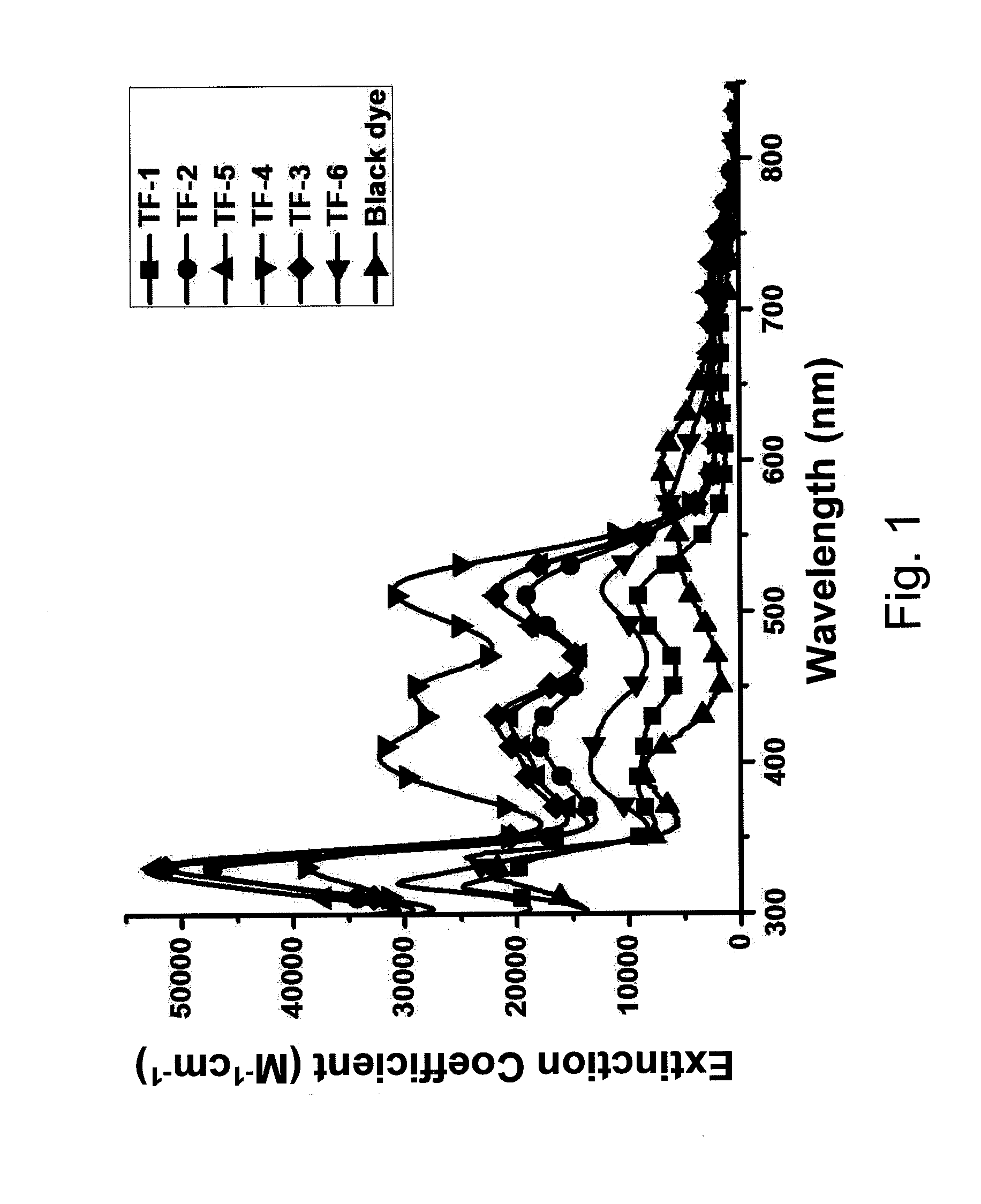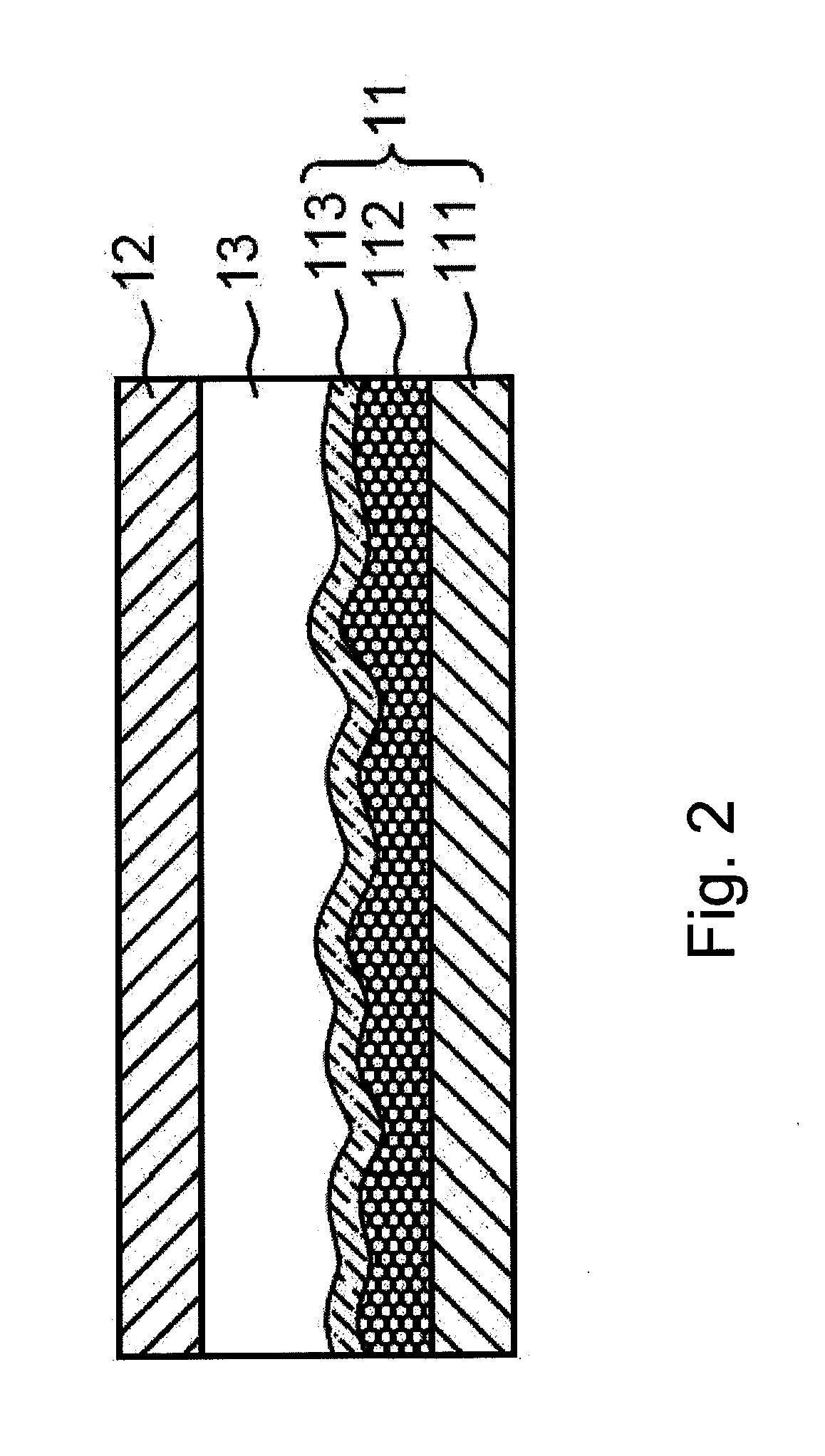Heteroleptic, dual tridentate ru(II) complexes as sensitizers for dye-sensitized solar cells
a solar cell and heteroleptic technology, applied in the field of solar sensitizers using heteroleptic, dual tridentate ru (ii) complexes and dye sensitization solar cells, can solve the problems of high cosub>2 /sub>exhaust, pollution of the atmosphere, and inability to meet the needs of the environment, so as to achieve better photoelectric conversion efficiency and high stability
- Summary
- Abstract
- Description
- Claims
- Application Information
AI Technical Summary
Benefits of technology
Problems solved by technology
Method used
Image
Examples
example ligands
[0025]The synthesis method and spectrum data for example ligand 1 having the tridentate ligand L2 and represented by the formula (15), where R4=H, is provided as following.
[0026]To a stirred suspension of NaOEt (1.25 g, 18.4 mmol) and THF (40 mL) at 0° C., a 30 mL THF solution of 2,6-diacetylpyridine (1 g, 6.1 mmol) and ethyl trifluoroacetate (2.18 mL, 18.4 mmol) were added in sequence. The mixture was heated at 80° C. for 12 h and then was neutralized with 2 M HCl until pH=5-6. After evaporating of THF, the residue was extracted with CH2Cl2 (3×80 mL). The combined extracts were washed with water, dried over anhydrous Na2SO4, and concentrated under vacuum to give the corresponding β-diketone compound. Without further purification, hydrazine monohydrate (98%, 2.9 mL, 59.9 mmol) was added into a 50 mL of EtOH solution of the aforementioned β-diketone reagent. The solution was reflux for 12 h and then the solvent was evaporated. The residue was redissolved in CH2Cl2 (100 mL), and the s...
example ru (
Example Ru(II) Complexes
[0031]In one embodiment, the Ru complex of the present invention is represented as formula (17).
[0032]A mixture of 2,6-bis(3-trifluoromethyl-1H-pyrazol-5-yl)pyridine (53 mg, 0.15 mmol), Ru(tectpy)Cl3 (100 mg, 0.15 mmol) and 4-ethylmorpholine (0.05 mL, 0.39 mmol) in 30 mL of ethanol was heated at 80° C. for 3 h. After evaporating the solvent, the aqueous phase was separated and the residue was extracted with CH2Cl2 (3×25 mL). The crude product was purified by silica gel column chromatography (hexane / ethyl acetate=1:1). After then, this solid was dissolved in a mixture of acetone (30 mL) and 1.5 M NaOH solution (1.8 mL). The solution was heated to 60° C. under N2 for 3 h. Finally, the solvent was removed, the solid was dissolved in 10 mL of H2O and was titrated with 2 N HCl to pH 3 to afford a black precipitate. This black product was washed with CH2Cl2 and acetone, to yield the compound of formula (17).
example 1
TF-1
[0033]
[0034]TF-1 is an example compound of formula (17), where R4═H and was prepared according to the afore-mentioned procedure. Yield: 78% (60 mg, 0.07 mmol).
[0035]Spectrum data of TF-1: MS (FAB, 102Ru): m / z 812 (M+1)+. 1H NMR (400 MHz, d6-DMSO, 298K): δ 9.37 (s, 2H), 9.14 (s, 2H), 8.17 (t, JHH=8.0 Hz, 1H), 8.06 (d, JHH=8.0 Hz, 2H), 7.70 (d, JHH=5.6 Hz, 2H), 7.59 (d, JHH=5.6 Hz, 2H), 7.19 (s, 2H); 19F NMR (376 MHz, d6-DMSO, 298K): δ−58.44 (s, 3F; CF3).
[0036]Anal. Calcd. for C31H16F6N8O6Ru.3H2O: C, 43.01; N, 12.94; H, 2.56. Found: C, 43.22; N, 12.71; H, 2.51.
PUM
 Login to View More
Login to View More Abstract
Description
Claims
Application Information
 Login to View More
Login to View More - R&D
- Intellectual Property
- Life Sciences
- Materials
- Tech Scout
- Unparalleled Data Quality
- Higher Quality Content
- 60% Fewer Hallucinations
Browse by: Latest US Patents, China's latest patents, Technical Efficacy Thesaurus, Application Domain, Technology Topic, Popular Technical Reports.
© 2025 PatSnap. All rights reserved.Legal|Privacy policy|Modern Slavery Act Transparency Statement|Sitemap|About US| Contact US: help@patsnap.com



